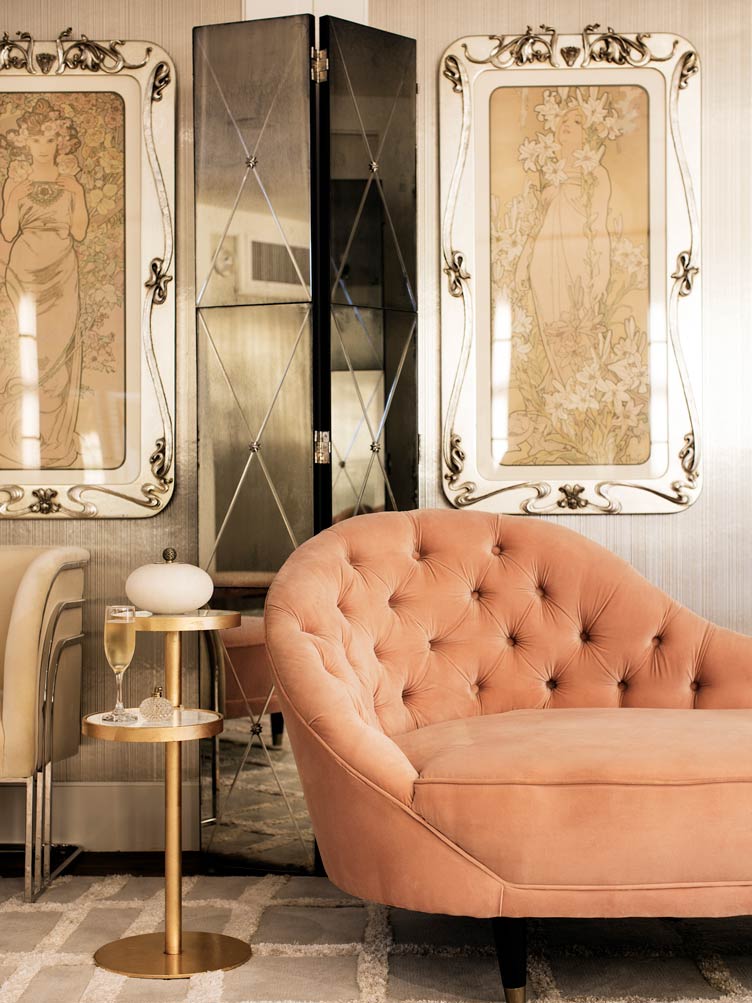To this day, Art Nouveau furniture and design is unmistakable: from the sinuous curves of the era’s hardwood furniture to the signature stained glass and its kaleidoscopic colorways, distinct and contemporary-seeming details abound. If you ever admired or actually own a classic Tiffany glass lamp, then Art Nouveau style is for you.
To shine a light on this classic style, we’re outlining the keystone traits of Art Nouveau, and offering up come easy ways to incorporate the look into your space (that won’t break the bank). Read on for your Art Nouveau cheat sheet.

GLASS & LIGHT
Whether looking to Mackintosh’s famed rose motif or the singular colored glass lamps by Louis Comfort Tiffany, it’s easy to recognize glass art from the Art Nouveau period. Playing with transparency and opacity and eventually stained glass, Art Nouveau artists turned glass into an admired medium by conceiving spectacular windows, vases, decorative boxes, and more. In addition to Tiffany lamps look for decorative objects like colored glass vases covered in floral etchings.
Tips to Get the Look in Your Space: Splurge on a panel of stained glass, which can be hung like artwork (or installed if you have the skills). While you can always opt for a new piece, there’s something to be said for the romance of old glass, which is thick and wavy.

INTRIGUING IRON WORK
Although Art Nouveau was born out of a backlash against the Industrial Revolution, Art Nouveau designers embraced industrial elements—like cast iron—with vigor. When it came to iron, specifically, there was no denying the aesthetic and functional potential it offered. You can find some of the strongest examples of the era’s iron work in the undulating balconies and jaw-dropping iron gates of Antoni Gaudi’s landmark Barcelona buildings, or the curvaceous balustrades on the staircases of Victor Horta’s UNESCO Brussels townhomes.
Tips to Get the Look in Your Space: Garden architecture like wrought iron doors, gates, and panels are an inspired way to bring iron into your home, whether they be repurposed as a headboard or wall hanging. In an outdoor setting, a pretty wrought iron bistro set would also be fitting.
NATURE ON DISPLAY
Plant shapes, florals, roots, buds, insects, and birds are all hallmarks of Art Nouveau style. A deep reverence for nature and the desire to create harmony with it drove the movement, informing the graphics and architectural details. In example, architectural pillars on buildings from the era appear to grow from the ground or burst with leaf-like shapes or blossoming blooms up top; and Art Nouveau patterns are full of twisting, curving lines that curl around each other and spread like trailing vines. Even furniture boasts legs that appear to mimic flower stems.
Tips to Get the Look in Your Space: Scout contemporary, nature-inspired furniture like gilded floral-base side tables or floral tole chandeliers, which will bring a taste of the outdoors in—no green thumb required.

DRAMATIC MINIMALISM
Despite all the floral motifs, natural materials, and interplay of texture and light, an obsession with the simplicity of all things Japanese (aka Japonisme) emerged during the Art Nouveau period. Blending the two concepts, designers merged organic forms with angled contours to fashion cutting-edge furniture. Architect and designer Charles Rennie Mackintosh pioneered the change, creating chairs with dramatically high backs, straight lines, and Shoji-style grids. Even those pieces that fall more firmly in the nature-inspired category, such as the marquetry works by French Art Nouveau designer Emile Gallé, retain a feeling of openness and restraint.
Tips to Get the Look in Your Space: Channel the look through Arts & Crafts style furniture, which relies on strong, grid-like structures. On mirrors and lamp shades, grids are sometimes imposed by way of leaded seams.

FLUID FORMS
The most definitive emblem of Art Nouveau style may just be the so-called whiplash line. Possessing the feelings of freedom and movement, the serpentine motif that mimics the cracking of a whip appears everywhere—from ironwork on buildings to textile patterns and the collectible posters of the period, including those by celebrated artists Henri de Toulouse-Lautrec. You’re also likely to see the whiplash in the art of Alphonse Mucha, the Czech artist who was famed for his interpretations of the goddess-like femme nouvelle.
Tips to Get the Look in Your Space: Art Nouveau lithographs are an inspired way to bring the sensuality of the whiplash line into your space. Specifically, look for pieces featuring the femme nouvelle, Art Nouveau’s most iconic symbol.
BIT OF HISTORY
Considered to mark the beginnings of the modernism movement, the Art Nouveau period only spanned from about 1890 to 1910. The movement signified a defining moment in the arts community when many broke away from the structure of academic art, along with the excessive flourishes of 19th-century design. Though brief in its existence, Art Nouveau has played a pivotal role in the history of the arts and even experienced a revival courtesy of the lush, swirly designs of the psychedelic 1960s.
Written by Madhu Puri












